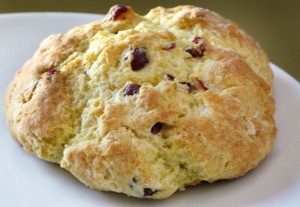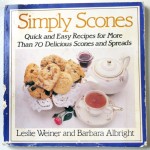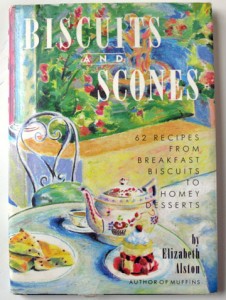 Long before “blog†was a term or even yet a twinkle in some bright penny’s eye, the name for my blog materialized. It was the early ‘90s, and through what I could have looked at as divine timing but instead considered professional misfortune, I was in a position where I was forced to make changes, forget my previous path and forge ahead with new pursuits. I was young and restless and wrestling with the ever-present questions of what did I like to do, what were my passions? Writing, of course, would always be my number one and seemingly undeterrable determination. But there were others. At the time, I had become obsessed with scones — baking them, eating them, rooting them out in cafes and bakeries like a French pig on the hunt for truffles. I even entertained the somewhat far-fetched fantasy of having a bakery of my own where scones would be featured. One day, my longtime friend and collaborator (who, hey, is still my longtime friend and collaborator!), began rattling off puns spun around scones as potential business identities (Sconic Youth, Rolling Scones, etc.). Many of them were quite ridiculous. Then – I’m not sure which one of us said it so I’ll give us both credit – we came up with “A Woman Sconed, “ which, yes, was also ridiculous, but had a ring to it. A ring of TRUTH! Here I was dejected and somewhat rejected and finding my therapy, once again, through baking. It fit! But what did it fit, exactly? What was I naming?
Long before “blog†was a term or even yet a twinkle in some bright penny’s eye, the name for my blog materialized. It was the early ‘90s, and through what I could have looked at as divine timing but instead considered professional misfortune, I was in a position where I was forced to make changes, forget my previous path and forge ahead with new pursuits. I was young and restless and wrestling with the ever-present questions of what did I like to do, what were my passions? Writing, of course, would always be my number one and seemingly undeterrable determination. But there were others. At the time, I had become obsessed with scones — baking them, eating them, rooting them out in cafes and bakeries like a French pig on the hunt for truffles. I even entertained the somewhat far-fetched fantasy of having a bakery of my own where scones would be featured. One day, my longtime friend and collaborator (who, hey, is still my longtime friend and collaborator!), began rattling off puns spun around scones as potential business identities (Sconic Youth, Rolling Scones, etc.). Many of them were quite ridiculous. Then – I’m not sure which one of us said it so I’ll give us both credit – we came up with “A Woman Sconed, “ which, yes, was also ridiculous, but had a ring to it. A ring of TRUTH! Here I was dejected and somewhat rejected and finding my therapy, once again, through baking. It fit! But what did it fit, exactly? What was I naming?
Years later, when the blog stampede began, I resisted. First off, I hate the term “blog,†but I guess it’s here to stay. Then I was a bit bothered by the fact that everyone and his mother could have a blog and it seemed the only prerequisite for having one was the ability to use a computer keyboard. I came from the school of hard knocks that said that any writing put out into the world for others to read must receive a stamp of approval from those in the know. Oh, how my thoughts have changed! I have since learned that while, yes, there is a glut of blogs out there and reading some of them, one questions the blogger’s ability to use a keyboard (meow!), there are a number of really good blogs and wonderful creative work being done. And why wait for the stamp of approval from anyone else? The beauty of these blogs is that they inspire a space for people to freely create, if only for themselves. Why must you need someone else to say yes to you for that? Say yes to yourself, says I! So with a blog, “A Woman Sconed†found its home with “womansconed.com.â€
Let me now provide a disclaimer: as odd as this sounds, “awomansconed.com†was claimed as a web domain before I could get it. I don’t know who the entity is who land-grabbed my domain, but I believe they perhaps unintentionally or intentionally, hoped to snare lookers for a woman scorned (persons more interested in tarts than scones), and I apologize for those of you who, by mistake, hit that spot first. And if you’ve landed here with the intention of finding a link to a “booty call†or some such perverted diversion, you need to attach the “a†to the sconed phrase (at least for the time being) and be on your merry and disgusting way! Or, stop here and enjoy something a little more wholesome.
For those of you consulting your dictionaries, don’t bother pointing out that “sconed†is not a word. I know that it is not. Well, it hasn’t been until now. Since it’s here in black and white, it deserves a definition. I’ve been mulling that over and consider the definition to be an evolving one (and if any of you have ideas, I’d love to hear them). But for now, I’ve come up with my feelings on what “sconed†means: transcending via culinary interest.
But what do “scones†mean to me? Why do I love them so…well, the scone is basically a biscuit (except scones are usually made with eggs while biscuits are not), and if there is someone out there who loves biscuits more than I, please come forth, I want to hear from you (I will be visiting the topic of biscuits in later entries). I can relate to scones — they are simple, unglamorous and somewhat modest-looking, yet satisfying to have in your company. Just sweet enough, but not a sugar overload. Sturdy! And I love to make them because they are simple and satisfying to create. They are comprised of some of the same basic ingredients, but with a few changes, become something completely different.
The origination and meaning of the name “scone†is as varied as the types of scones that exist, according to “Simply Scones†by Leslie Weiner and  Barbara Albright. It is possible they are simply named after the Scottish town of Scone. Or, the word could come from the Middle Dutch schoon (bright) broot (bread). Or, depending on what type of scones you have eaten, you may align with the possible Gaelic origination, which is sgonn, meaning “shapeless mass or large mouthful.â€
Barbara Albright. It is possible they are simply named after the Scottish town of Scone. Or, the word could come from the Middle Dutch schoon (bright) broot (bread). Or, depending on what type of scones you have eaten, you may align with the possible Gaelic origination, which is sgonn, meaning “shapeless mass or large mouthful.â€
I ate my first scone many years ago at a café/book shop in Santa Barbara called The Earthling (sadly, no longer in business), which had the most delightful mural on one wall made up of nearly life-sized portraits of famous authors. The scone was served to me heated, a mountain of lemon and poppy seeds, bursting with fresh blueberries. I dissolved into bliss, devouring the warm, crumbling creature. I was hooked. I had to bake scones of my own. This was pre-recipe-at-your-keyboard strokes, so I went hunting for a cookbook and landed a treasure – “Biscuits and Scones†by Elizabeth Alston. After much deliberation over the enticing array of scone recipes in the book, I chose as my first foray Orange Almond Scones, which incorporated a flavorful and intriguing array of ingredients: orange zest, freshly squeezed orange juice, yogurt, almond extract and chopped almonds. The scone dough was shaped into balls that ended up huge mounded golden-brown rounds. The scones were so tender, almost delicate in texture, buttery and bright in both flavor and color. The orange and almond made them fragrant to the tongue, as well as the nose. They became my scone of choice to make for teas, special breakfasts and office functions. But I have made quite a number of others, probably at least 20 different kinds.
In 2008, I decided to take on the Scone-of-the-Month project, where I would pick 12 different scone recipes to try throughout the year. Many of them came from a wonderful website, joyofbaking.com, which is filled with recipes and photographs that do not disappoint. From there, I found such delights as Chocolate Scones, Scones filled with Jam, Gingerbread Scones and Irish Apple Scone Cake. I also picked recipes (Chocolate Chip Scones, Peggy’s Cheese Scones) from the aforementioned “Biscuits and Scones,†as well as  making such gems as Carrot-Nut Scones and Apple Oat Scones from “Simply Scones.†In “Cooks Illustrated†magazine, I found a wonderful blueberry scone recipe where the dough is folded like a flag before rolling it out, giving it a near-perfect, layered texture. And a traditional currant scone recipe from the “Betty Crocker Cookbook,†was a very basic recipe that yielded a very satisfying scone. In all, it was a satisfying year. I challenge anyone to pick a type of food, whether it be scones, pies, pasta, salad dressings, sandwiches or whatever, and try out one new recipe each month for a year. Hey, what about Pancake-of-the-Month?
making such gems as Carrot-Nut Scones and Apple Oat Scones from “Simply Scones.†In “Cooks Illustrated†magazine, I found a wonderful blueberry scone recipe where the dough is folded like a flag before rolling it out, giving it a near-perfect, layered texture. And a traditional currant scone recipe from the “Betty Crocker Cookbook,†was a very basic recipe that yielded a very satisfying scone. In all, it was a satisfying year. I challenge anyone to pick a type of food, whether it be scones, pies, pasta, salad dressings, sandwiches or whatever, and try out one new recipe each month for a year. Hey, what about Pancake-of-the-Month?
Probably the best technique advice I can give on making scones is that they, like biscuits, require a light hand. Over-mixing or over-kneading this type of bread will result in a tough, dull scone. Use fresh ingredients, including baking powder, so your scones will lift off! Use cold butter (and a warm heart) and cut it into small cubes before you “cut†it into the flour mixture. (Note to novice bakers: cutting butter into flour means blending it in by squeezing it in between your fingers and meshing it with the flour until it makes the flour look slightly coarse, like cornmeal, as it is described in many recipes. If you have warm fingers – as I sometimes do – you’ll find a wonderful tool in a pastry blender, so that the butter remains cold for the proper baking chemistry. But cutting the butter in with your fingers is a wonderful sensation not to be missed). And a tip on consuming: eat the scones warm, either fresh out of the oven or reheated in the microwave or toaster oven.
This won’t be my last word on scones in this space. I’ll keep trying new scone recipes and have a number of them waiting for me. Perhaps it’s nostalgia, however, that keeps me coming back to my golden orange favorites. I share them here. Eat them smeared with butter, jam of your choice and if you want a really rich treat, try them with Devonshire cream.
Orange-Almond Scones
(from “Biscuits and Scones†by Elizabeth Alston)
½ cup freshly squeezed orange juice
¼ cup buttermilk, plain yogurt or milk
1 large egg
¼ teaspoon almond extract
3 cups all-purpose flour
4 teaspoons baking powder
½ teaspoon baking soda
¼ teaspoon salt
8 tablespoons (1 stick) cold unsalted butter, cut up
½ cup granulated sugar
½ cup finely chopped blanched almonds
1 tablespoon freshly grated orange peel
Heat oven to 375 degrees. Grate the peel before juicing the orange. Measure juice, then buttermilk in a 2-cup glass measure. Add egg and extract; beat smooth with a fork.
Put flour, baking powder, baking soda and salt into a large bowl. Stir to mix well. Add butter and cut in with a pastry blender or rub in with your fingers until the mixture looks like fine granules. Add sugar, almonds and orange peel; toss to distribute evenly. Add egg mixture and stir with a fork until a soft dough forms.
Turn out dough onto a lightly floured board and give 5 to 6 kneads, just until well mixed. Form dough into a ball; cut into 8 wedges. Form each wedge into a ball and place on an ungreased baking sheet.
Bake about 25 minutes, or until medium brown. Cool on a wire rack.
Blogger’s Note: I often toss ½ to 2/3 cup of dried cranberries into this recipe when adding the zest, sugar and almonds. Also, be sure and use a large cookie sheet (I use a big-un – 15-/12-by-20-inch) for baking these scones, placing the unbaked scones at least 3 inches apart on the sheet, as the scones will rise and spread.
